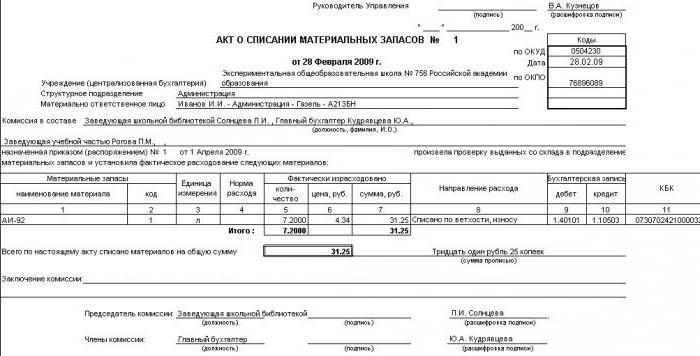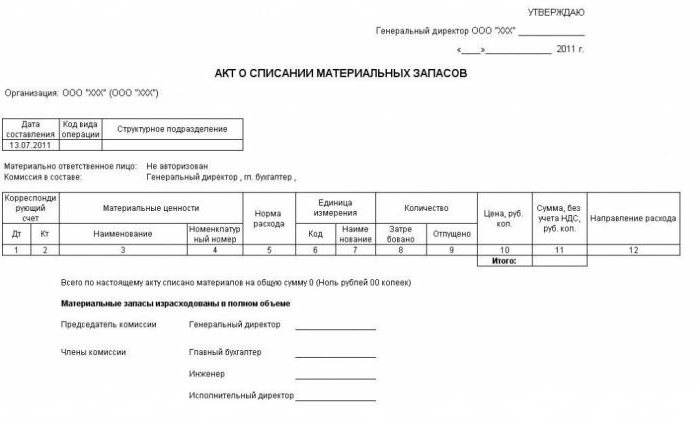Inventories of the enterprise are used to ensure rhythmic work and the proper organization of the production process. Over time, they gradually become unusable, and the need arises to write them off. This must be done in accordance with generally accepted rules. For such purposes, a document has been specially developed, which is called the act of writing off inventories.
Basic concepts
All inventories involved in the production process are divided into: production and commodity. Some provide uninterrupted operation, and the second are finished goods and are intended to be sent to the consumer. Some of them, for unforeseen reasons, become unusable and accordingly drop out of the total. A document that reflects such a fact is the act of writing off inventories. In addition to the production itself, its availability is of particular importance for accounting.

The act on writing off inventories serves as a means for making separate accounting entries. They are needed in order to keep records of all materials to be disposed of. An act to write off inventories is usually drawn up, usually after taking an inventory. It can be planned (monthly, quarterly or head-on) or sudden. The reason is determined by the head of the enterprise. He appoints a commission that will examine the stocks available at the factory.
Document form
By order of the Ministry of Finance of Russia No. 52n, issued on March 30, 2015, a new form of the act of writing off inventories was approved. It was introduced in exchange for the one that the State Standard of Russia introduced in December 1993 by its decree No. 299. In fact, it is not much different from the previous version. But experts say the new act most fully and clearly describes the entire procedure for identifying exhausted stocks.

The form of the document is as follows:
- At the top of the sheet in the center is its name, number and date of compilation.
- Next, data about the organization itself is reported. On the right is a table indicating the document code for OKUD.
- The composition of the commission is listed below, as well as the number of the order or instruction on the basis of which it operates. The reason for the verification is immediately indicated.
- Next is a table into which it will be necessary to collect all the information. It specifically describes the movement of each material with an indication of quantity, amount and purpose.
- Completes the calculation of the total amount debited.
- After that, the commission makes its conclusion.
- At the very end, all members together with the chairman put their signatures.
The act is transferred to the accounting department, where the specialist who maintains the materials makes his notes.
Write-off Documentation
The following documents are the basic basis for writing off materials:
- planned cost estimate
- report on the quantity produced for a specific period of production,
- stock utilization report.
Based on the data obtained, then an act of writing off inventories is compiled. In this case, you can take a standard form or use your own blank.

The form of such a document is developed by accounting specialists. They try to take into account all the features of the production process in this enterprise. Such a replacement is not prohibited by law, since the approved form of the form is only advisory in nature. The rest of the form is completely arbitrary. The most important thing is that it takes into account the main points:
- Details act and data on the order on the basis of which it is drawn up.
- Be sure to indicate the date and place of the inspection.
- Full list of commission members.
- All data on materials to be written off.
- Reasons for cancellation. Here it is necessary to indicate what went into production and what went into disrepair or became a marriage as a result of a failure or oversight of employees.
- Calculation of the total cost of materials for cancellation.
- Signatures of the participants.
Typically, such an act at the enterprise is approved by the head. Only after that is it used by accountants to make transactions.








